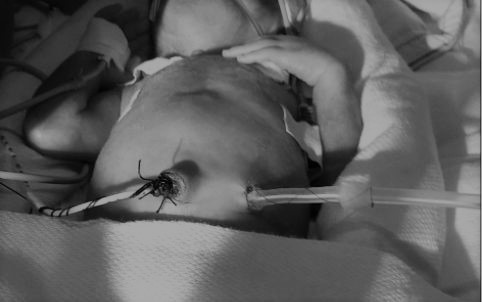Non-oliguric hyperkalemia in a very low birth weight neonate
Main Article Content
Abstract
Background: Non-oliguric hyperkalemia of the newborn occurs during the first 72 hours of life, mainly in those born before 28 weeks of gestational age. Case report: newborn of 27.2 weeks of gestational age, presenting hyperkalemia from the first hours of life, without oliguria and with adequate renal function (non-oliguric hyperkalemia). Clinically, he presented extreme bradycardia accompanied by electrocardiographic abnormalities (acuminate T waves and widening of the QRS complex). Several pharmacological treatment options were used, and no response was obtained; it was necessary to perform peritoneal dialysis, with which it was possible to normalize potassium concentrations and reverse the cardiac alterations presented. Conclusions: non-oliguric hyperkalemia in the newborn is an infrequent but severe complication that can compromise the patient's life if a timely diagnosis and treatment are not performed. In this neonate, peritoneal dialysis was an effective therapeutic option, allowing serum potassium concentrations to be normalized. There were no secondary complications when proceeding despite its extremely low weight.
Downloads
Article Details

This work is licensed under a Creative Commons Attribution-NonCommercial-NoDerivatives 4.0 International License.
Creative Commons
License Attribution-NonCommercial-ShareAlike 4.0 International (CC BY-NC-SA 4.0)
You are free to:
Share - copy and redistribute the material in any medium or format.
Adapt - remix, transform, and build upon the material The licensor cannot revoke these freedoms as long as you follow the license terms.
• Attribution — You must give appropriate credit, provide a link to the license, and indicate if changes were made. You may do so in any reasonable manner, but not in any way that suggests the licensor endorses you or your use.
• NonCommercial — You may not use the material for commercial purposes.
• ShareAlike — If you remix, transform, or build upon the material, you must distribute your contributions under the same license as the original.
• No additional restrictions — You may not apply legal terms or technological measures that legally restrict others from doing anything the license permits.
References
Cavagnaro F. El riñón del niño prematuro: riesgos a largo plazo. Rev Chil Pediatr. 2020; 91(3):325-330. DOI: https://doi.org/10.32641/rchped.v91i3.1607
Monteverde ML. Injuria renal aguda neonatal. Rev Nefrol Dial Traspl. 2019; 39(2): 134-148.
Wright CJ, Posencheg MA, Seri I, Evans JR. Líquidos, electrólitos y equilibrio acidobasico. En: Gleason ChA, Juul SE. Avery. Enfermedades del recién nacido. 10ma ed. Barcelona: Elsevier; 2018. P 368-398. DOI: https://doi.org/10.1016/B978-0-323-40139-5.00030-9
Doherty EG. Control de líquidos y electrólitos. En: Eichenwald EC, Hansen AR, Martin CR, Stark AR. Cloherty and Starks Manual of Neonatal Care. South Asian Edition, New Delhi: Wolters Kluwer Health; 2021. P. 343-361.
Blanco Santos A. Homeostasis del potasio. Monog Nefrol. 2019; 1(1):11-20.
Flores Delgado A, Hernández García LR, Beltrán Reyes P, Silerio Maqueo G, Ahumada Ayala M. Homeostasia del potasio: bases fisiopatológicas de las tubulopatías hereditarias. Med Int Mex. 2021; 37(2):230-243.
Kwak JR, Gwon M, Lee JH, Park MS, Kim SH. Non-Oliguric Hyperkalemia in Extremely Low Birth Weight Infants. Yonsei Med J. 2013; 54(3):696-701. DOI: https://doi.org/10.3349/ymj.2013.54.3.696
Vidmar E, Pavcnik M. Treatment of non-oliguric hyperkalaemia with inhaled salbutamol in premature infants with severe respiratory distress syndrome. SIGNA VITAE. 2018; 14(1):88-91. DOI: https://doi.org/10.22514/SV141.032018.16
Kiran CR, Das SK, Udayakanth M, Amarendra M. ICH/IVH a consequence of Non Oliguric Hyperkalemia with Hypoglycemia in a late preterm with Perinatal Asphyxia: A case report. Int J Med Sci Clin Inv. 2015; 2(6): 1032-1034.
Xiong X, Chen D, Zhang J, Mao J, Li J. Nonoliguric hyperkalemia in a late preterm infant with severe birth asphyxia. Transl Pediatr. 2013; 2(1):48-52.
Pérez González E, Marín Serra J. Evaluación de la función renal en el recién nacido. Protoc Diagn Ter Pediatr. 2014; 1:37-51.
Mc Donough AA, Youn JH. Potassium homeostasis: The knowns, the unknowns, and the health benefits. Physiology. 2017; 32(2):100-111. DOI: https://doi.org/10.1152/physiol.00022.2016
Bohorquez Rivero JJ, Restom Arrieta J, Pineda Paternina M, Cantillo García K, Montoya Jaramillo M. Concepciones Diagnósticas y Manejo de Hiperpotasemia en el Paciente con Enfermedad Renal Crónica: Revisión a Propósito de un Caso Clínico. Arch Med. 2016; 16(2):1-6.
Kara A, Kaya Gurgoze M, Aydin M, Taskin E, Bakal U, Orman A. Acute peritoneal dialysis in neonatal intensive care unit: An 8 year experience of referral hospital. Pediatrics and Neonatology. 2018; 59:375-379. DOI: https://doi.org/10.1016/j.pedneo.2017.11.008
Comité Nacional de Nefrología. Consenso de Lesión Renal Aguda en el recién nacido. Arch Argent Pediatr. 2020; 118(1):50-58. DOI: https://doi.org/10.5546/aap.2020.s50





